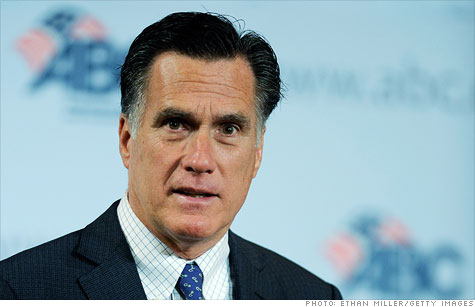Search News

Mitt Romney on the campaign trail.
NEW YORK (CNNMoney) -- Mitt Romney made two big changes to his tax plan last week, and according to a new analysis, they will be very expensive.
Like $3.4 trillion expensive.
Previously, Romney had said he would "maintain current tax rates on personal income" as president before moving to a "fairer, flatter, simpler tax structure" in the future.
Now Romney appears to be accelerating that timetable, announcing a move that would reduce the current top rate paid on income from 35% to 28%, with similar reductions across all tax brackets.
Americans in the lowest bracket would pay 8% instead of 10%. Individuals closer to the middle would pay 20% instead of 25%.
In addition to the changes to the marginal income tax rates, Romney also said he plans to eliminate the Alternative Minimum Tax.
The twin changes will come at a cost of more than $3.4 trillion over 10 years, according to a new estimate from the Tax Policy Center.
By 2022, the 20% reduction in rates would add $357 billion in debt that year alone, while eliminating the AMT would cost $94 billion.
And that's assuming the Bush tax cuts are extended, something most experts think will happen -- at least for a majority of taxpayers.
If all the Bush tax cuts were allowed to expire, Romney's cuts would be even more severe when compared to a current law baseline.
Howard Gleckman, a resident fellow at the Urban Institute, wrote in a blog post that the changes are "really, really expensive."
Essentially, the cuts would create a $3.4 trillion hole in the budget, over a time period in which deficits are already set to be quite large.
For its part, the Romney campaign disputes any claim that his plan would add to the deficit. The cuts "will be fully paid for through a combination of economic growth, base broadening and spending restraint," said Andrea Saul, a Romney spokesperson.
Portions of the tax cuts would be offset by implementing "curbs on personal tax deductions, exemptions and credits."
But the campaign has not spelled out which tax cuts it wants to kill, making it difficult to score.
The campaign has also said the tax cuts will spur growth that will, in turn, create additional revenue for the federal government. The TPC analysis does not take that growth into account.
"I suspect [the tax cuts] would boost growth, but nobody has a credible way to measure by how much," Gleckman said.
The candidate's initial economic plan -- released in September -- was billed by the Romney campaign as "the most detailed plan for economic growth and job creation of any presidential candidate."
But it fell flat with some influential conservatives, including the Wall Street Journal editorial board, which labeled the proposals "surprisingly timid and tactical."
The Tax Foundation, a think tank that generally advocates for lower tax rates, said that Romney's initial plan for the individual code "really takes no step toward fundamental reform."
The updated plan reiterates other proposals that were first laid out in September, including provisions that would eliminate taxes on interest, dividends and capital gains for taxpayers who make less than $200,000.
It also calls for the elimination of the estate tax, and a reduction in the tax rate paid by corporations from 35% to 25%.
On corporate taxes, Romney still favors higher rates than his competitors.
Romney's 25% proposed rate carries a less aggressive reduction than that of Gingrich (12.5%), Rick Santorum (17.5%) or Ron Paul (15%). ![]()
| Overnight Avg Rate | Latest | Change | Last Week |
|---|---|---|---|
| 30 yr fixed | 3.80% | 3.88% | |
| 15 yr fixed | 3.20% | 3.23% | |
| 5/1 ARM | 3.84% | 3.88% | |
| 30 yr refi | 3.82% | 3.93% | |
| 15 yr refi | 3.20% | 3.23% |
Today's featured rates:
| Latest Report | Next Update |
|---|---|
| Home prices | Aug 28 |
| Consumer confidence | Aug 28 |
| GDP | Aug 29 |
| Manufacturing (ISM) | Sept 4 |
| Jobs | Sept 7 |
| Inflation (CPI) | Sept 14 |
| Retail sales | Sept 14 |